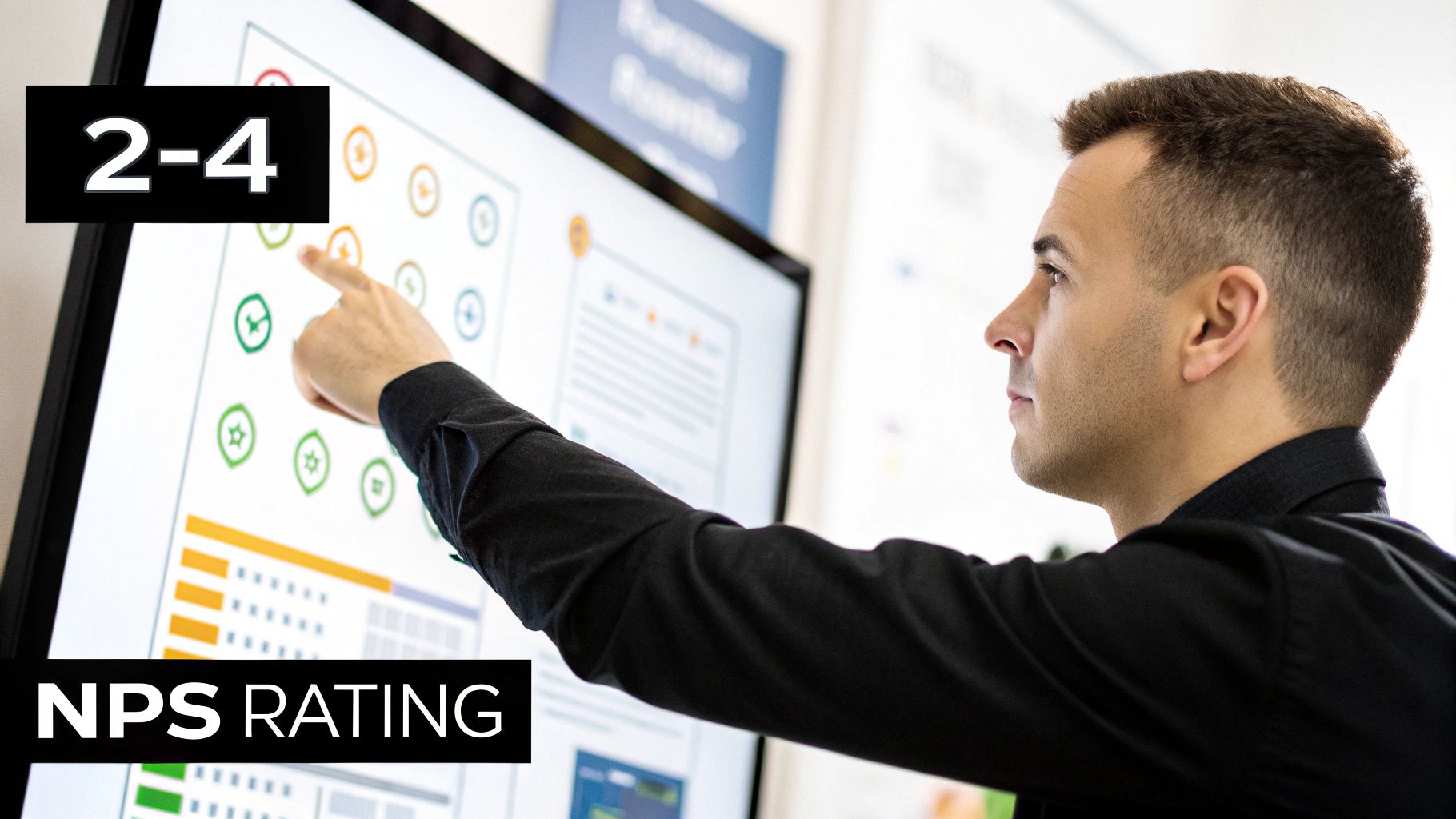In today's competitive landscape, exceptional customer service is a critical differentiator. But how do you objectively measure success and drive meaningful improvement? The answer lies in tracking the right key performance indicators for customer service (KPIs). Moving beyond generic metrics allows you to diagnose issues, empower your team, and strategically enhance customer loyalty.
This guide provides a detailed roundup of the most impactful KPIs that every organisation should monitor. We will explore not just what to measure, but how to calculate it, what good looks like, and how to implement these metrics to transform your service operations. For a comprehensive overview of critical metrics to track, many sources point to similar core indicators, such as this list of 8 Essential Customer Service KPIs for 2025, which reinforces the importance of a focused approach.
For businesses using advanced unified communications platforms, integrating these KPIs directly into your contact centre and CRM provides a powerful, real-time view of performance. This enables data-driven decisions that boost both customer satisfaction and your bottom line. Below, we dissect each essential metric, providing the practical, actionable insights needed to turn your support centre into a proven driver of business growth.
1. Customer Satisfaction Score (CSAT)
Customer Satisfaction Score (CSAT) is one of the most direct and widely adopted key performance indicators for customer service. It measures how satisfied a customer is with a specific interaction, product, or the service they just received. This metric provides immediate, transactional feedback, making it an invaluable tool for gauging short-term happiness and pinpointing specific areas for improvement. CSAT is typically measured through a single-question survey, asking "How satisfied were you with your recent [interaction/purchase]?" Customers respond on a numerical scale, often 1-5 or 1-10.

This KPI is highly effective because of its simplicity. For instance, Amazon uses it after a support chat to rate the agent's performance, while Uber prompts for a ride rating immediately after a journey concludes. These quick feedback loops allow companies to instantly assess service quality.
How to Calculate and Implement CSAT
Calculating your CSAT score is straightforward. You divide the number of satisfied customers (those who rated 4 or 5 on a 5-point scale) by the total number of survey responses, then multiply by 100 to get a percentage.
Formula: (Number of Satisfied Customers / Total Number of Survey Responses) x 100 = % CSAT
To effectively implement CSAT, consider these actionable strategies:
- Timing is Critical: Send the survey immediately after the service interaction, whether it is a support call, a chat session, or a purchase. This ensures the experience is fresh in the customer's mind.
- Keep it Brief: The most effective CSAT surveys are short, often just one or two questions. A long survey will discourage responses and dilute the value of the feedback.
- Close the Loop: Actively follow up on negative scores. A personalised outreach to an unhappy customer can turn a poor experience into a positive one and provides crucial insights into service failures.
- Segment Your Data: Do not just look at the overall score. Analyse CSAT results by agent, support channel, customer type, or issue category to identify specific strengths and weaknesses within your operation.
2. Net Promoter Score (NPS)
Net Promoter Score (NPS) is a powerful metric that gauges long-term customer loyalty and brand sentiment. Unlike transactional KPIs, NPS measures the overall relationship a customer has with your company by asking one simple yet profound question: "On a scale of 0-10, how likely are you to recommend our company/product/service to a friend or colleague?" This makes it one of the most vital key performance indicators for customer service, as it reflects the cumulative impact of all customer interactions.

Based on their responses, customers are categorised into three groups: Promoters (score 9-10), who are enthusiastic advocates; Passives (score 7-8), who are satisfied but not loyal; and Detractors (score 0-6), who are unhappy and can damage your brand through negative word-of-mouth. Companies like Apple, known for their loyal customer base, and Tesla have historically maintained high NPS scores, demonstrating the metric's link to brand strength and growth.
How to Calculate and Implement NPS
The NPS calculation involves subtracting the percentage of Detractors from the percentage of Promoters. The resulting score can range from -100 (all Detractors) to +100 (all Promoters). Passives are excluded from the final calculation but are included in the total number of respondents.
Formula: (% Promoters – % Detractors) = NPS Score
To effectively implement NPS, consider these actionable strategies:
- Survey at Key Milestones: Deploy the NPS survey at crucial points in the customer journey, such as after onboarding or a significant purchase, to capture relationship-level feedback rather than just transactional satisfaction.
- Analyse the 'Why': The real value of NPS comes from the follow-up question: "What is the primary reason for your score?" Use this qualitative feedback to understand the drivers behind the numbers and prioritise improvements.
- Implement a Closed-Loop Process: Systematically follow up with Detractors to resolve their issues and with Promoters to thank them and gather testimonials. This shows you value their feedback and can turn critics into fans.
- Focus on Trends, Not Just a Number: Track your NPS score over time. A single score is a snapshot, but the trend reveals whether your customer experience initiatives are genuinely improving loyalty and strengthening your position among key performance indicators for customer service.
3. First Contact Resolution (FCR)
First Contact Resolution (FCR) measures the percentage of customer queries resolved during the first interaction, without the need for any follow-up contact. It is one of the most powerful key performance indicators for customer service because it directly correlates with both customer satisfaction and operational efficiency. A high FCR rate signifies that agents are well-equipped to handle issues effectively, which reduces customer effort and lowers service costs by minimising repeat contacts.
This KPI is a cornerstone for high-performing support teams. For instance, Zappos empowers its agents with extensive training to achieve an 85% FCR, while Progressive Insurance improved its FCR by 15% through enhancements to its internal knowledge base. These examples show how investing in agent resources directly translates to better, more efficient service.
How to Calculate and Implement FCR
Calculating FCR is straightforward, though defining a "resolved" case is crucial. You divide the number of issues resolved in a single contact by the total number of customer issues handled.
Formula: (Total Number of Issues Resolved on First Contact / Total Number of Customer Issues) x 100 = % FCR
To successfully implement and improve FCR, focus on these strategic actions:
- Invest in Knowledge: A comprehensive and easily searchable internal knowledge base is non-negotiable. Equip agents with the information they need to solve problems without escalation.
- Implement Skill-Based Routing: Route complex or specialised inquiries directly to agents with the specific expertise required to handle them. This prevents transfers and callbacks.
- Analyse Repeat Contacts: Systematically track and analyse why customers have to make contact more than once. Use these insights to identify gaps in processes, training, or agent knowledge.
- Validate Internally and Externally: Do not just rely on agents marking a ticket as resolved. Use post-interaction surveys asking customers, "Was your issue resolved in this one contact?" to get a true measure of your FCR performance.
4. Average Response Time
Average Response Time is a fundamental KPI that measures the average duration a customer must wait before receiving an initial response from a service agent. This metric is a direct reflection of a company's efficiency and commitment to timely communication. In an era where customers expect swift resolutions, a low Average Response Time is critical for maintaining satisfaction and preventing minor issues from escalating. It is one of the most important key performance indicators for customer service because it directly impacts customer perception of your brand's attentiveness.
For example, leading brands set high standards. HubSpot aims for a one-minute average chat response time, while Buffer commits to replying to social media inquiries within an hour. These benchmarks demonstrate how prioritising speed can significantly enhance the customer experience across different communication platforms.
How to Calculate and Implement Average Response Time
Calculating Average Response Time involves summing up all the individual response times for a given period and dividing that total by the number of responses sent.
Formula: (Total Time Taken to Respond to all Inquiries / Total Number of Responses) = Average Response Time
To effectively manage and improve this crucial KPI, consider these actionable strategies:
- Set Channel-Specific Targets: Recognise that customer expectations vary by channel. A response time of one hour may be excellent for email but unacceptable for live chat. Establish distinct, realistic targets for phone, email, chat, and social media.
- Use Automated Acknowledgements: Implement automated replies to confirm receipt of an inquiry. This simple step manages customer expectations by letting them know their message has been received and when they can anticipate a human response.
- Monitor in Real-Time: Utilise dashboards to track response times as they happen. This allows supervisors to proactively manage agent workloads, reallocate resources during peak times, and prevent backlogs from forming.
- Establish Escalation Procedures: Define clear protocols for time-sensitive or high-priority issues. If an inquiry is not addressed within a specific timeframe, it should be automatically escalated to a senior agent or manager to ensure a prompt resolution. An effective omnichannel contact centre can streamline these escalations across all channels.
5. Customer Effort Score (CES)
Customer Effort Score (CES) is a powerful transactional metric that measures how much effort a customer had to exert to get an issue resolved, a request fulfilled, or a question answered. Popularised by the Corporate Executive Board (now Gartner), the core idea is that loyalty is driven more by making service easy than by delighting customers. CES surveys typically ask customers to rate their agreement with a statement like, "The company made it easy for me to handle my issue," often on a 1-7 scale.

This KPI is highly predictive of future customer behaviour. For example, Southwest Airlines used CES feedback to streamline its check-in process, reducing friction and improving loyalty. Similarly, a study found that 94% of customers who reported low effort said they would repurchase, while 81% of those with high effort said they would speak negatively about the company. This makes CES an essential addition to any set of key performance indicators for customer service.
How to Calculate and Implement CES
The CES score is calculated by finding the average of all responses. You simply add up all the individual scores and divide by the total number of responses.
Formula: (Sum of all Scores / Total Number of Responses) = CES Score
To effectively implement CES and reduce customer effort, consider these actionable strategies:
- Survey Immediately: Just like CSAT, CES surveys should be sent right after a specific interaction, such as a support ticket resolution or an account update. This ensures the customer's memory of the effort involved is accurate.
- Focus on Process Improvement: The primary value of CES is in identifying and fixing high-effort processes. Use the feedback to pinpoint bottlenecks, confusing IVR menus, or repetitive agent questions that frustrate customers.
- Prioritise Journey Enhancements: Use CES scores to prioritise which parts of the customer journey need the most urgent attention. A low score on a critical touchpoint like account recovery, as Google discovered, can be a major source of churn.
- Combine with Other Metrics: CES works best when analysed alongside CSAT and NPS. A customer might be satisfied (CSAT) but have expended a lot of effort (CES), signalling a potential long-term loyalty risk that other metrics would miss.
6. Average Handle Time (AHT)
Average Handle Time (AHT) is a fundamental operational metric among key performance indicators for customer service, especially in call centres. It measures the average duration of a complete customer interaction, from the moment an agent begins the engagement until all post-interaction work is finished. This includes talk time, hold time, and any after-call work (ACW) required to resolve the customer's query. AHT is a critical measure of agent efficiency and operational performance.
While speed is important, AHT must be balanced with service quality. For instance, a company like Delta Airlines might focus on reducing AHT through enhanced agent training and better knowledge base access, ensuring agents can find information faster without sacrificing the quality of support. Similarly, Comcast has improved its AHT by optimising call routing, so customers reach the right department faster, reducing transfers and overall interaction time.
How to Calculate and Implement AHT
AHT is calculated by adding your total talk time, total hold time, and total after-call work, then dividing that sum by the total number of calls handled. The result is the average time spent on each interaction.
Formula: (Total Talk Time + Total Hold Time + Total After-Call Work) / Total Number of Interactions = AHT
To effectively implement and manage AHT, consider these actionable strategies:
- Balance with Quality Metrics: Never optimise for AHT in isolation. Monitor it alongside CSAT and First Contact Resolution (FCR) to ensure that faster service does not lead to lower satisfaction or unresolved issues.
- Empower Agents with Tools: Provide your team with an organised, easily searchable knowledge base and efficient CRM tools. Quick access to information is one of the fastest ways to reduce talk and hold times.
- Analyse AHT by Issue Type: Segment AHT data by the type of query or customer segment. This helps identify complex issues that naturally require longer handling times, allowing you to set more realistic targets and pinpoint specific training needs.
- Focus on Coaching, Not Just Targets: Use AHT data to identify agents who may need additional support or coaching. Reviewing calls with high AHT can reveal knowledge gaps or process inefficiencies that can be addressed through targeted training.
7. Customer Retention Rate
Customer Retention Rate (CRR) measures the percentage of customers a company retains over a specific period. It is one of the most vital key performance indicators for customer service because it directly reflects customer loyalty and the long-term health of the business. Unlike transactional metrics, CRR provides a strategic view of how well your service, products, and overall experience are creating lasting relationships. High retention is a clear sign that customers find ongoing value in what you offer, making it a powerful indicator of sustainable growth.
This KPI is critical because acquiring a new customer can be five to 25 times more expensive than retaining an existing one. Companies renowned for their customer experience, like Apple and Amazon, boast impressive retention rates (over 90%) by creating ecosystems and service models that foster deep loyalty. This demonstrates a direct link between superior service and long-term business success.
How to Calculate and Implement CRR
Calculating your Customer Retention Rate involves tracking the number of customers at the start and end of a period, while accounting for new customers acquired during that time.
Formula: (([Number of Customers at End of Period – Number of New Customers Acquired]) / Number of Customers at Start of Period) x 100 = % CRR
To effectively implement and improve your CRR, consider these actionable strategies:
- Focus on Customer Success: Go beyond reactive support. Proactively engage with customers to ensure they are getting the maximum value from your product or service. This shifts the focus from just solving problems to helping them achieve their goals.
- Analyse Churn Reasons: Do not just track who leaves; understand why. Regularly analyse churn data to identify common pain points, service gaps, or product shortcomings. Use this insight to make targeted improvements.
- Implement Loyalty Programmes: Reward long-term customers with exclusive benefits, discounts, or early access to new features. A well-designed loyalty programme can significantly increase the incentive for customers to stay. Making it easy for loyal customers to contact you, for instance with a free toll number, can further enhance their experience.
- Segment Your Retention Data: Monitor CRR across different customer segments (e.g., by plan type, acquisition channel, or industry). This allows you to identify which groups are most at risk and tailor your retention strategies accordingly.
8. Service Level Agreement (SLA) Compliance
Service Level Agreement (SLA) Compliance is a critical set of key performance indicators for customer service that measures a team's adherence to predefined commitments. These formal agreements outline specific, measurable targets for service delivery, such as response times, resolution times, and system uptime, ensuring a consistent and reliable customer experience. Tracking SLA compliance provides a clear, objective benchmark for performance and holds service departments accountable to both internal standards and customer expectations.

This KPI is vital for organisations promising a certain level of service quality. For instance, Amazon Web Services (AWS) provides detailed SLA commitments for its cloud services, offering service credits if they fail to meet specified uptime percentages. Similarly, logistics companies like FedEx commit to precise delivery timeframes, offering money-back guarantees if they fail to comply. These public commitments build trust and set clear performance standards.
How to Calculate and Implement SLA Compliance
SLA compliance is typically calculated as the percentage of cases or interactions that met the agreed-upon standards within a given period. The specific formula depends on what is being measured (e.g., first response time, resolution time).
Formula for Response Time SLA: (Number of Responses Meeting SLA / Total Number of Inquiries) x 100 = % SLA Compliance
To effectively implement and manage your SLAs, consider these actionable strategies:
- Set Realistic Targets: Establish SLAs that are challenging yet achievable. Unrealistic goals can demoralise your team, while targets that are too easy will not drive improvement. Analyse historical performance data to set an informed baseline.
- Communicate Clearly: Ensure that both your agents and your customers understand the SLA terms. Agents need to know their targets, and customers should know what level of service to expect.
- Automate Monitoring: Implement automated systems to track performance against SLAs in real-time. Use alerts to notify supervisors and agents when an SLA is at risk of being breached, allowing for proactive intervention. You can learn more about creating a robust framework by exploring this service level agreement template.
- Review and Adapt: SLAs are not static. Regularly review performance data and customer feedback to refine and update your agreements. As your business evolves, your service commitments should evolve with it to remain relevant and effective.
Key Metrics Comparison for Customer Service
| Metric | Implementation Complexity 🔄 | Resource Requirements 🔄 | Expected Outcomes 📊 | Ideal Use Cases 💡 | Key Advantages ⭐⚡ |
|---|---|---|---|---|---|
| Customer Satisfaction Score (CSAT) | Low – simple surveys, easy setup | Low – quick surveys, minimal tools | Immediate feedback on specific interactions | Measuring short-term satisfaction per touchpoint | Easy to implement, real-time feedback, cost-effective ⭐⚡ |
| Net Promoter Score (NPS) | Moderate – single question setup | Moderate – requires periodic surveys | Measures customer loyalty and growth potential | Tracking overall customer loyalty and advocacy | Strong growth predictor, widely benchmarked, simple to communicate ⭐📊 |
| First Contact Resolution (FCR) | High – needs robust tracking systems | High – training, multi-channel support | Increased efficiency, higher satisfaction | Optimizing issue resolution efficiency | Reduces customer effort and costs, boosts agent morale ⭐⚡ |
| Average Response Time | Low – straightforward time tracking | Moderate – monitoring tools by channel | Improves customer experience by quick responses | Managing customer expectations across channels | Easy to measure, directly impacts satisfaction, SLA tracking ⚡📊 |
| Customer Effort Score (CES) | Moderate – survey design critical | Moderate – tailored surveys | Predicts loyalty based on effort reduction | Identifying friction in customer processes | Strong loyalty indicator, drives operational improvements ⭐📊 |
| Average Handle Time (AHT) | Moderate – needs detailed time tracking | Moderate – data from CRM and systems | Operational efficiency and workforce planning | Measuring overall interaction efficiency | Critical for workforce management, identifies training needs ⚡⭐ |
| Customer Retention Rate | Moderate – requires customer tracking | Moderate – longitudinal data analysis | Indicates loyalty & revenue sustainability | Monitoring long-term customer loyalty trends | Direct revenue impact, signals business health ⭐📊 |
| SLA Compliance | High – requires comprehensive monitoring | High – monitoring infrastructure | Ensures service targets and customer trust | Managing formal service commitments and contracts | Creates accountability, supports competitive differentiation ⭐⚡ |
From Data to Decisions: Activating Your KPIs for Success
Mastering the key performance indicators for customer service is not simply an exercise in collecting data; it's about transforming raw numbers into a strategic roadmap for excellence. Throughout this guide, we have explored a balanced set of metrics that provide a 360-degree view of your support operations. From the operational precision measured by Average Handle Time (AHT) and First Contact Resolution (FCR) to the crucial customer perceptions captured by CSAT, NPS, and Customer Effort Score (CES), each KPI tells a vital part of your customer service story.
The true power of these metrics is realised when they are viewed not in isolation, but as an interconnected ecosystem. A drop in FCR might lead to a dip in your CSAT scores, while an obsessive focus on reducing AHT could negatively impact customer satisfaction if agents rush interactions. Understanding these relationships is the first step towards building a truly customer-centric organisation. By analysing these indicators together, you can identify trends, diagnose underlying issues, and make informed adjustments that enhance both efficiency and customer delight.
Your Path to Data-Driven Excellence
Embarking on this journey requires a commitment to a new way of operating. To truly activate your customer service KPIs for success, understanding the broader principles of data-driven decision making is crucial. It’s about building a culture where data informs every aspect of your customer service strategy.
Here are your actionable next steps:
- Start Small, Scale Smart: You don't need to implement all eight KPIs at once. Select two or three that align with your most pressing business goals. Perhaps you start with CSAT to gauge overall satisfaction and AHT to optimise resource allocation. Master these, then gradually introduce others.
- Establish Clear Baselines and Targets: Before you can improve, you must know where you stand. Measure your current performance for a set period to establish a baseline. Then, set realistic, incremental improvement targets that are ambitious yet achievable for your team.
- Integrate KPIs into Your Daily Rhythm: Make these metrics a part of your team's routine. Discuss them in daily stand-ups, use them in one-on-one coaching sessions, and display them on real-time dashboards. This constant visibility reinforces their importance and encourages a collective sense of ownership.
- Empower Your Agents: Share performance data with your agents and train them on what each KPI means. When agents understand how their actions directly influence metrics like FCR and CES, they become proactive partners in improving the customer experience.
Ultimately, leveraging key performance indicators for customer service is about moving from a reactive support function to a proactive engine for business growth. When you consistently meet your SLAs and improve customer retention, you are not just solving problems; you are building lasting relationships, fostering loyalty, and creating a powerful competitive advantage that drives your bottom line.
Ready to transform your customer service with powerful, integrated analytics? Cloud Move provides a unified platform to track, visualise, and act on all your essential KPIs in real-time. Unify your communication channels and empower your team with the data they need to deliver exceptional service by exploring Cloud Move today.




